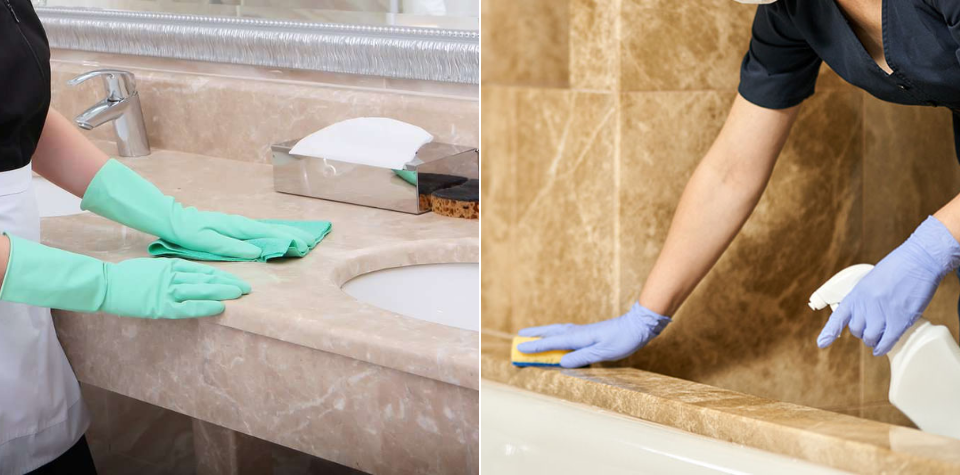Difference Between Marble and Italian Marble

Which is Cheaper, Rajasthan Granite or South Granite?
March 8, 2024
Difference Between White Marble and White Quartzite
March 11, 2024Marble has captivated the human imagination for centuries, with its timeless elegance and unparalleled beauty. Its versatility in design and durability have made it a favorite choice for architects, interior designers, and homeowners alike.
However, within the realm of marble, there exists a distinction that often confounds many the difference between marble and Italian marble.
In this blog post, we delve into the intricacies of these two exquisite materials, shedding light on their characteristics, origins, and unique qualities.
Understanding Marble

Marble, in its essence, is a metamorphic rock primarily composed of recrystallized carbonate minerals, typically calcite or dolomite.
Formed from limestone subjected to intense heat and pressure deep within the earth’s crust, marble emerges with a distinctive crystalline structure, often featuring veins and patterns that add to its aesthetic allure.
Renowned for its luxurious appearance and enduring quality, marble has been prized for millennia in architectural marvels, sculptures, and interior décor.
Exploring Italian Marble

Italian marble, on the other hand, is a specific type of marble revered for its unparalleled quality, exquisite beauty, and historical significance.
Quarried from the rich deposits nestled within the majestic Italian Alps, Italian marble boasts a legacy steeped in centuries of artistry and craftsmanship.
Renowned worldwide for its purity, durability, and timeless appeal, Italian marble sets the benchmark for excellence in the world of natural stone.
Difference Between Marble and Italian Marble

Marble, with its timeless beauty and versatile applications, has long been a cornerstone of architecture and design. However, within the realm of marble lies a distinction that often perplexes enthusiasts: the difference between marble and Italian marble.
In this exploration, we uncover the nuances between these two exquisite materials, shedding light on their characteristics, origins, and unique qualities.
Characteristics
| Aspect | Marble | Italian Marble |
|---|---|---|
| Composition | Metamorphic rock primarily composed of carbonate minerals such as calcite or dolomite | Same fundamental composition as marble but distinguished by superior purity and crystalline structure, often containing higher concentrations of calcite |
| Colors & Veining | Varied colors and veining patterns depending on the specific geological conditions of the quarry | Wide array of colors and intricate veining patterns, ranging from pristine whites to rich hues, known for its distinct aesthetic appeal |
| Texture | Smooth surface with occasional natural imperfections | Smooth surface with a high polish, exhibiting remarkable clarity and depth, often perceived as more luxurious |
| Durability | Durable and resistant to heat and moisture | Exceptionally durable and resistant to wear, making it ideal for high-traffic areas and outdoor applications |
Origins
- Marble: Quarried from various regions worldwide, including Italy, Greece, Turkey, and Spain, with each locale imparting its unique characteristics to the stone.
- Italian Marble: Sourced exclusively from the renowned quarries nestled within the Italian Alps, particularly the Carrara region, celebrated for its premium quality and purity.
Unique Qualities
- Marble: Renowned for its versatility, marble finds application in a myriad of architectural and decorative purposes, from flooring and countertops to sculptures and monuments.
- Italian Marble: Revered for its exceptional quality, Italian marble sets the standard for luxury and sophistication, favored by discerning designers and homeowners seeking timeless elegance.
Cultural Significance
- Marble: Throughout history, marble has been synonymous with opulence and grandeur, adorning iconic landmarks such as the Parthenon in Greece and the Taj Mahal in India.
- Italian Marble: Reflecting Italy’s rich artistic heritage, Italian marble holds a revered place in the annals of art and architecture, immortalized in masterpieces by renowned sculptors and architects.
Benefits of Using Marble and Italian Marble

Marble, a symbol of timeless sophistication, has long been cherished in architectural and design spheres. Italian marble, in particular, stands as the epitome of luxury and refinement, boasting superior quality and aesthetic allure. Let’s delve into the distinct advantages of utilizing both marble and Italian marble in various design projects.
Benefits Comparison
| Benefits | Marble | Italian Marble |
|---|---|---|
| Timeless Elegance | Infuses spaces with timeless beauty and sophistication | Embodies unparalleled luxury and refinement |
| Versatility | Adaptable to diverse design applications | Allows for bespoke design with exclusive varieties |
| Durability | Surprisingly resilient and suitable for high-traffic areas | Renowned for longevity and enduring quality |
| Heat Resistance | Ideal for kitchen countertops and fireplace surrounds | Highly resistant to heat, perfect for various applications |
| Property Value Increase | Enhances property value with its luxury association | Adds prestige and exclusivity, appealing to discerning buyers |
Additional Benefits of Italian Marble
| Additional Benefits | Italian Marble |
|---|---|
| Unrivaled Quality | Sets the standard for luxury and excellence, known for impeccable craftsmanship |
| Exquisite Aesthetics | Features vibrant colors, intricate veining, and unparalleled clarity, elevating any space |
| Cultural Heritage | Carries a rich legacy of Italian craftsmanship and tradition, adding heritage and prestige |
| Longevity | Ensures durability and enduring beauty, making it a worthwhile investment for generations |
| Distinctiveness | Offers exclusive varieties like Carrara, Calacatta, and Statuario, allowing for bespoke designs |
Marble and Italian marble offer a myriad of benefits, from timeless elegance and durability to cultural heritage and exclusivity. Whether enhancing residential interiors or commercial spaces, these exquisite materials continue to captivate with their unmatched beauty and enduring allure, making them indispensable elements in architectural and design endeavors.
Price Comparison: Marble vs. Italian Marble in India
Marble and Italian marble are both highly esteemed materials in the Indian construction and interior design industries. However, understanding the cost disparity between these two varieties is crucial for informed decision-making.
In this analysis, we delve into the price comparison between marble and Italian marble in India, providing insights into their respective costs based on various factors.
💡Check All Types of Marble Latest Price List!
📌 Price Comparison
| Factors | Marble | Italian Marble |
|---|---|---|
| Quarry Location | Varied, including domestic quarries and global sources. | Exclusive sourcing from Italy, particularly Carrara and Tuscany. |
| Quality and Rarity | Variable quality and availability, ranging from affordable to premium selections. | Renowned for superior quality and exclusivity, often premium priced. |
| Varieties Available | Wide range of options available, with prices starting from ₹50 to ₹500 per square foot. | Limited varieties with distinct characteristics, prices typically start from ₹200 to ₹2000 per square foot. |
| Processing Techniques | Standard processing methods. | May require specialized processing techniques, adding to cost. |
| Market Demand | Demand influenced by trends and local preferences. | High demand due to reputation for luxury and prestige. |
| Installation Costs | Typically standard installation costs. | Similar installation costs to marble, but may require specialized expertise. |
The cost difference between marble and Italian marble in Indian construction and design is influenced by factors like quality, rarity, variety, market demand, and processing techniques. While marble offers versatility and affordability, Italian marble offers superior quality and exclusivity at a higher price.
Best Uses of Marble & Italian Marble in Interiors

Marble and Italian marble, with their timeless beauty and unparalleled elegance, have long been coveted materials in interior design. From classic to contemporary spaces, these luxurious stones add a touch of sophistication and refinement to any setting.
1. Flooring
Marble and Italian marble flooring exude opulence and grandeur, making a striking statement in entryways, living rooms, and dining areas. The smooth, polished surface of marble reflects light, brightening up spaces and creating an illusion of spaciousness. Italian marble, with its exquisite veining patterns and vibrant hues, adds a touch of luxury to high-traffic areas like foyers and corridors.
2. Countertops and Kitchen Islands
In kitchens, marble and Italian marble countertops and islands offer both functionality and style. Their heat-resistant properties make them ideal for cooking and baking, while their natural beauty enhances the aesthetic appeal of the space. Italian marble, such as Carrara or Calacatta, lends a timeless elegance to kitchen surfaces, elevating the overall design.
3. Bathroom Walls and Vanity Tops
Marble and Italian marble are popular choices for bathroom walls, shower surrounds, and vanity tops, creating a spa-like ambiance. Their water-resistant properties and easy maintenance make them practical options for wet areas. Italian marble, in particular, adds a touch of luxury to bathrooms, transforming them into serene retreats.
4. Fireplace Surrounds
A marble or Italian marble fireplace surround instantly becomes the focal point of a room, adding warmth and sophistication. The natural veining and patterns of these stones create a captivating visual display, enhancing the ambiance of living rooms and cozy spaces. Italian marble, such as Statuario or Arabescato, lends a sense of drama and elegance to fireplace designs.
5. Wall Cladding and Feature Walls
Marble and Italian marble wall cladding and feature walls infuse interiors with texture, depth, and visual interest. Whether used in living rooms, bedrooms, or dining areas, these stones create a sense of luxury and refinement. Italian marble feature walls, with their unique veining and patterns, become striking focal points in contemporary interiors.
6. Decorative Accents
From furniture accents to decorative objects, marble and Italian marble add a touch of sophistication to interior decor. Whether in the form of tabletops, lamps, or sculptures, these stones lend a sense of timeless elegance to any space. Italian marble accents, with their intricate detailing and craftsmanship, become cherished heirlooms in the home.
Marble and Italian marble are versatile materials that elevate interiors with their timeless beauty and luxurious appeal. They can be used for flooring, countertops, walls, or decorative accents, adding sophistication and refinement to any space.
Conclusion
Incorporating marble and Italian marble into your interior design projects is an investment in luxury, sophistication, and timeless elegance.
Whether you’re looking to elevate your home or commercial space, these exquisite stones offer unmatched versatility and aesthetic appeal.
From flooring and countertops to wall cladding and decorative accents, marble and Italian marble from Bhutra Marble & Granites in Kishangarh, Rajasthan, India, are crafted to perfection, promising to transform your space into a sanctuary of style and refinement.
With their natural beauty, durability, and enduring allure, marble and Italian marble stand as testaments to exquisite craftsmanship and impeccable taste.
Choose Bhutra Marble & Granites for your marble and Italian marble needs and embark on a journey of unparalleled luxury and elegance.
FAQs
Q1. What makes marble and Italian marble ideal choices for interior design?
Marble and Italian marble are renowned for their timeless beauty, versatility, and durability. They add a touch of sophistication and elegance to any interior space, making them ideal choices for flooring, countertops, wall cladding, and decorative accents.
Q2. What is the difference between marble and Italian marble?
While both marble and Italian marble share similar properties, Italian marble is distinguished by its superior quality, exquisite veining patterns, and exclusivity. Italian marble, sourced from quarries in Italy, particularly Carrara and Tuscany, is renowned for its luxurious appeal and unparalleled craftsmanship.
Q3. What are the best uses of marble and Italian marble in interiors?
Marble and Italian marble are versatile materials that can be used in various interior design applications, including flooring, countertops, bathroom walls, fireplace surrounds, wall cladding, and decorative accents. Their natural beauty and durability make them perfect choices for both residential and commercial spaces.
Q4. Are marble and Italian marble suitable for high-traffic areas?
Yes, both marble and Italian marble are durable and resilient materials, making them suitable for high-traffic areas such as entryways, hallways, and living rooms. Proper sealing and maintenance can further enhance their longevity and performance in these spaces.
Q5. What is the maintenance required for marble and Italian marble?
Marble and Italian marble require regular cleaning with a mild soap and water solution to remove dirt and debris. Additionally, it’s essential to seal the surface periodically to protect against stains and moisture damage. Avoid using harsh chemicals or abrasive cleaners, as they can damage the stone’s surface.





